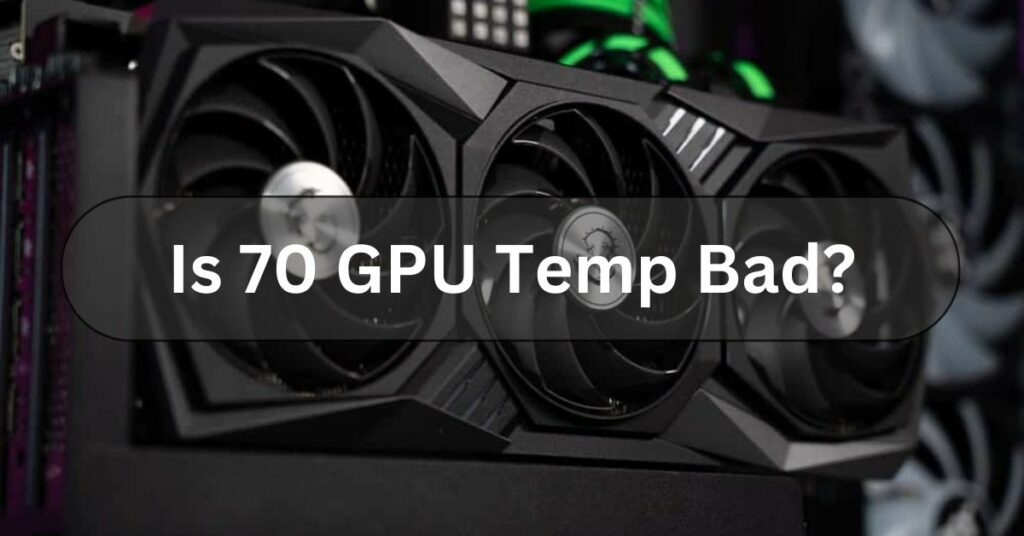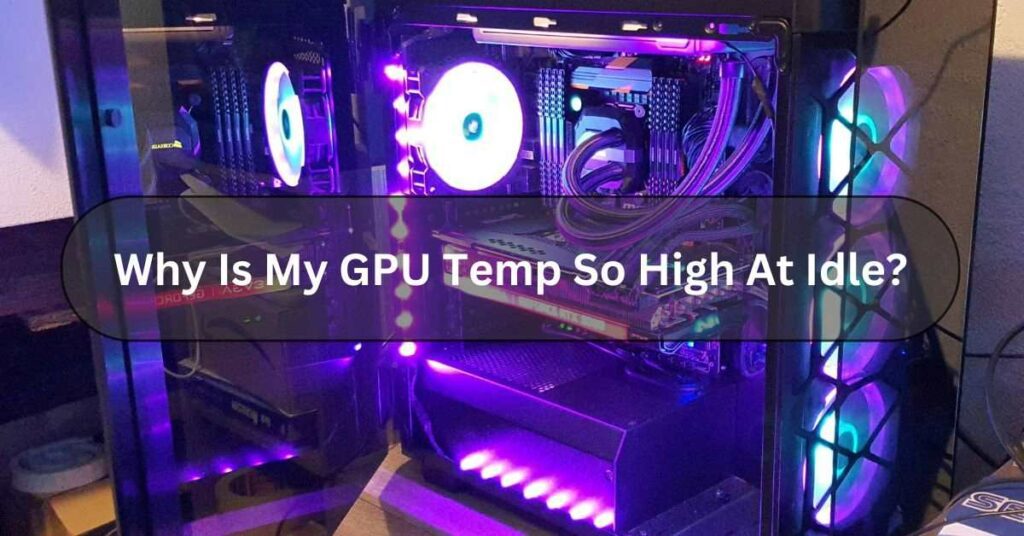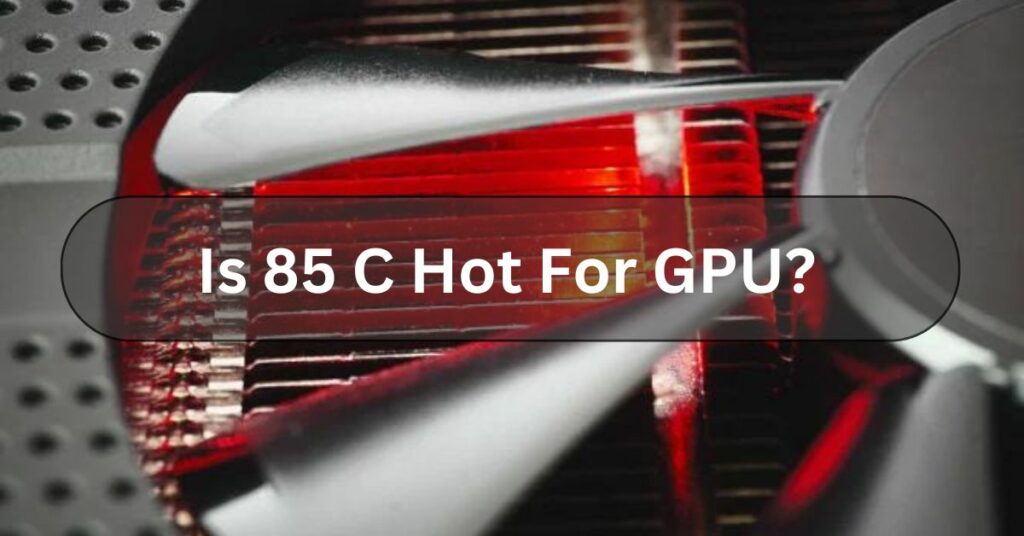In the world of PC gaming and graphic-intensive tasks, ensuring your GPU (Graphics Processing Unit) operates at an optimal temperature is crucial for performance and longevity.
The good temperature for your GPU (Graphics Processing Unit) is usually around 60-70 degrees Celsius when gaming and around 30-40 degrees Celsius when idle. These temperatures keep your GPU running smoothly without getting too hot or cold.
In my experience, I’ve learned how crucial it is to keep your GPU temperature in check. I’ll be sharing simple tips to help your graphics card run smoothly.
What Is A Good GPU Temp? – Check GPU Temperature!
Your GPU (Graphics Processing Unit) works hard when you’re gaming or doing other graphics-intensive tasks.
Keeping it at the right temperature is crucial for its performance and longevity. Generally, a good GPU temperature is around 60-70 degrees Celsius when gaming. It should be cooler if it’s just sitting idle, ideally around 30-40 degrees Celsius.
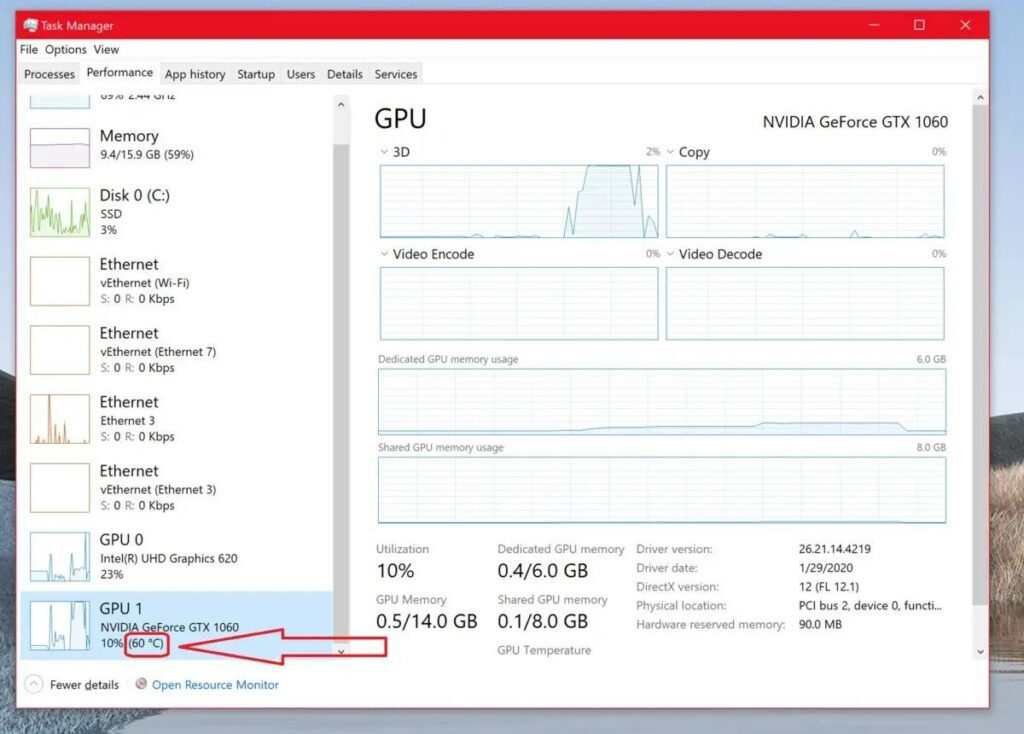
These temperatures help your GPU work efficiently without overheating, which could lead to performance issues or even damage over time.
Keeping an eye on your GPU temperature and ensuring it stays within these ranges helps keep your system running smoothly.
What Is Safe GPU Temperature When Gaming?
When you’re gaming, it’s important to keep an eye on your GPU temperature to ensure it stays within safe limits.
Generally, a safe GPU temperature during gaming is around 60-85 degrees Celsius, depending on your graphics card model and the intensity of your gameplay.
Read Also: Why Do My GPU Fans Keep Turning On And Off
What Is Good GPU Temperature When The PC Is Idle?
When your PC is idle, meaning you’re not actively using it for any intensive tasks like gaming or video editing, a good GPU temperature typically falls between 30 to 40 degrees Celsius.
At this temperature range, your graphics card is not under heavy load and can remain cool without needing to work hard.
Keeping your GPU cool during idle times helps it last longer and perform better when required. Plus, Keeping an eye on its temperature can reveal any cooling system issues.
How Do We Check GPU Temperature?
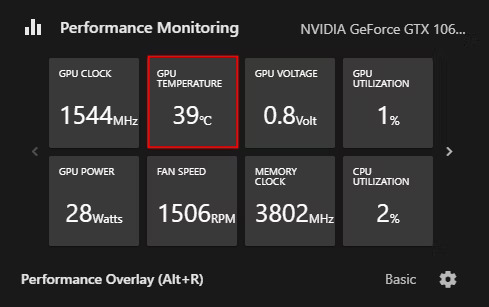
To check your GPU temperature quickly:
- Utilize software tools such as MSI Afterburner or GPU-Z.
- Look for built-in monitoring in NVIDIA’s GeForce Experience or AMD’s Radeon Software.
- Check BIOS/UEFI settings.
- Physically inspect for overheating.
- Consider third-party apps like NZXT CAM.
What To Do If GPU Temperature Is High?
If your GPU temperature is high, here’s what you can do:
- Check airflow and clear vents.
- Keep your PC clean to prevent dust buildup.
- Change the fan speed or think about adding more cooling options.
- Monitor performance regularly.
- Reduce overclocking if applicable.
- Ensure proper case placement for ventilation.
- Update graphics card drivers and close unnecessary programs.
- Consider upgrading to a more efficient GPU if necessary.
Read Also: What GPU Can Run 240hz?
The Importance Of Good GPU Temperature – Here To Know!
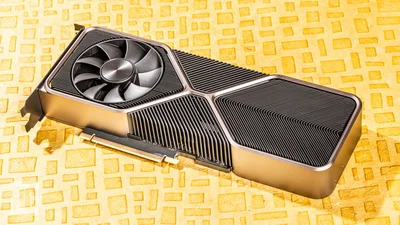
Understanding GPU Temperature:
- Your GPU is the workhorse behind rendering stunning graphics and powering immersive experiences on your computer.
- Like any electronic component, GPUs generate heat during operation, adversely affecting performance and lifespan if not managed properly.
- Monitoring and maintaining an optimal GPU temperature ensures smooth operation, prevents thermal throttling, and prolongs the life of your graphics card.
Optimal GPU Temperature Range:
- While GPUs can withstand higher temperatures, operating within a specific temperature range is crucial for optimal performance and longevity.
- A good GPU temperature typically falls between 65°C to 85°C under load, but staying below 80°C is recommended for most graphics cards.
- Exceeding safe temperature limits can lead to thermal throttling, reduced performance, and potential hardware damage over time.
Consequences Of High GPU Temperature:
- High GPU temperatures can result in thermal throttling, where the GPU reduces its clock speed to prevent overheating.
- Thermal throttling decreases performance, causes frame rate drops, and causes stuttering in games or applications.
- Leaving your GPU exposed to high temperatures for too long can cause permanent damage, leading to costly repairs or replacements.
Effective Strategies For Maintaining A Good GPU Temp – Complete Guide!

Proper Ventilation And Airflow:
- Ensure your PC case has adequate airflow by strategically positioning the intake and exhaust fans.
- Regularly remove dust buildup from fan blades, heatsinks, and air vents to improve airflow and heat dissipation.
- Consider installing additional case fans or upgrading to a more efficient cooling solution, such as liquid or aftermarket GPU coolers.
Adjust Fan Speed And Profile:
- Utilize software tools like MSI Afterburner or EVGA Precision X to customize fan curves and adjust fan speeds based on GPU temperature.
- Increase fan speeds during heavy gaming sessions or graphic-intensive tasks to maintain a cooler GPU temperature.
- Experiment with different fan profiles to find the balance between cooling performance and noise levels that suit your preferences.
Monitor GPU Temperature:
- Install GPU monitoring software like GPU-Z or HWMonitor to keep track of your graphics card’s temperature in real time.
- Set up temperature alerts or overlays to receive notifications when the GPU temperature exceeds safe thresholds.
- Regularly monitor temperature trends and identify any potential issues before they escalate into serious problems.
Proper Case Placement:
- Position your PC case in a well-ventilated area with sufficient clearance for airflow around the case.
- Avoid placing your PC in enclosed spaces or against walls that restrict airflow and trap heat.
- Consider using a PC case with good cable management options to prevent cable clutter and improve airflow within the case.
Read Also: Is 85 C Hot For GPU?
What Are Ideal & Dangerous Temps For Your CPU And GPU?
Your computer’s CPU (Central Processing Unit) and GPU (Graphics Processing Unit) can get hot when they’re working hard. It’s important to keep an eye on their temperatures to make sure they stay within safe limits.
Ideal Temperatures:
- For most CPUs, The ideal temperature range is between 40°C to 70°C (104°F to 158°F) when under load.
- GPUs typically operate well between 30°C to 80°C (86°F to 176°F) under load.
Dangerous Temperatures:
- If your CPU reaches temperatures above 80°C (176°F) or your GPU climbs above 90°C (194°F), it could lead to performance issues or even damage.
- Exceeding these temperatures frequently can reduce the lifespan of your components and may cause instability or crashes.
How to Monitor Temperatures:
- You can use software tools like MSI Afterburner, HWMonitor, or NZXT CAM to keep track of your CPU and GPU temperatures.
- Make sure your computer has proper ventilation and cooling systems to help maintain safe temperatures.
Good GPU Temp Guidelines – Comparison Table!
| Temperature Range | Description |
| Below 60°C | Excellent, optimal cooling |
| 60°C – 70°C | Good, ideal for most GPUs |
| 70°C – 80°C | Acceptable. Monitor closely |
| 80°C – 85°C | Elevated, potential throttling |
| Above 85°C | High risk of hardware damage |
Frequently Asked Questions:
1. What Are Good Temps For CPU And GPU?
Good temperatures for your CPU and GPU are typically around 60-70 degrees Celsius when gaming or under heavy load and around 30-40 degrees Celsius when idle.
2. Is 53c GPU Temp Good?
Yes, A GPU temperature of 53°C is generally considered good. It’s within the normal range for many graphics cards and indicates that your GPU is running at a moderate temperature, which is ideal for maintaining performance and longevity.
3. Is 70c A Good GPU Temp?
Yes, 70°C is generally considered a good GPU temperature. It’s within the acceptable range for most GPUs and shouldn’t cause any issues with performance or longevity.
4. Should I Be Worried About My GPU Temperature?
No worries! If your GPU temperature is within the normal range (around 60-70 degrees Celsius during gaming and 30-40 degrees Celsius when idle), there’s usually no need to fret. But if it can get up to 70-74c° on more demanding games now you need to be worried.
5. What Exactly Are Safe GPU Temps?
Safe GPU temperatures are typically around 60-70 degrees Celsius when gaming and 30-40 degrees Celsius when idle. These temperatures help your GPU perform well without overheating or getting too cold, which can affect its lifespan and performance.
6. Is 80 C Too Hot For GPU?
Yes, 80°C is considered too hot for a GPU. Keeping your GPU temperature lower is important to avoid potential damage and ensure optimal performance.
7. What Is A Normal GPU Temp While Gaming?
A good temperature for your graphics card while gaming is between 70 and 85 degrees Celsius (around 158 to 185 degrees Fahrenheit). It’s normal for Nvidia cards to run a bit warmer than AMD cards. An occasional jump above this range shouldn’t be a big deal, but if your graphics card gets too hot for too long, it could break or wear out faster.
8. Normal GPU Temperature?
Normal GPU temperature depends on what your computer is doing:
- Idle: When your computer is just sitting there, Aim for around 30 to 45 degrees Celsius (86 to 113 degrees Fahrenheit). That’s like a warm summer day.
- Gaming: When you are playing a game, The GPU works harder and gets hotter. A safe range is between 65 and 85 degrees Celsius (149 and 185 degrees Fahrenheit). Imagine a hot cup of coffee.
9. How Long Can I Play On 75 GPU Temp?
A 75°C GPU temperature is safe for gaming for long periods. Most GPUs are designed to handle much higher temps, up to around 90°C.
10. Is It Good A Temperature Of 31-35C Graphics Card?
Yes, A temperature of 31-35°C for a graphics card is good. It’s on the warmer side, But still well within normal operating range. Most graphics cards are designed to safely operate up to 80-90°C, so 31-35°C is quite cool.
11. What Should Be The Normal Temperature Of A GPU On Gaming & Without Gaming?
Your GPU gets hot like most things that work hard inside your computer. Here’s a quick guide to how hot is normal:
- Gaming: Ideally, Aim for between 65 and 85 degrees Celsius (149 and 185 degrees Fahrenheit). If it gets hotter, try keeping your computer cool and well-ventilated.
- Not Gaming (Idle): When you’re just browsing the web or doing light tasks, your GPU shouldn’t be working very hard. Aim for a temperature around 30 to 50 degrees Celsius (86 to 113 degrees Fahrenheit).
12. Is 67-70c A Good GPU Temperature On 100% Usage?
Yes, 67-70°C is a good temperature for your GPU to be running at under 100% usage. Typically, Anything under 85°C is considered safe for extended gaming sessions.
13. What Is The Optimal CPU And GPU Temperature For Gaming?
The best optimal temperature for your CPU and GPU when gaming is usually between 60 to 80 degrees Celsius.
14. What Is An Ideal GPU Temperature?
An ideal GPU temperature depends on what you’re doing with your computer. Here’s a quick guide:
- Gaming: Aim for between 65 and 85 degrees Celsius (149-185 degrees Fahrenheit). This is a safe zone for most GPUs under load.
- Idle: When you’re not gaming or using demanding programs, Ideally your GPU would be around 30 to 45 degrees Celsius (86-113 degrees Fahrenheit).
Basically, the cooler the better, But even up to 85 degrees Celsius is generally considered safe for gaming.
15. How To Check Your Graphics Card’s GPU Temperature?
Check your GPU temperature:
- The Easy Way: Press Ctrl+Shift+Esc, click “Performance” then “GPU” in Task Manager.
- More Features: Use your graphics card’s software (Nvidia: GeForce Experience, AMD: Radeon Software).
- More Options: Download free programs like Open Hardware Monitor or HWiNFO.
Safe GPU temp is under 80°C (176°F). If it gets hotter, your computer might slow down.
Conclusion:
In Conclusion, Maintaining a good GPU temperature is vital for keeping your graphics card running smoothly and prolonging its lifespan. The good temperature for your GPU is around 60-70 degrees Celsius when gaming and around 30-40 degrees Celsius when idle.
Read Also: Why Is My GPU Temp So High At Idle? Do GPU Come With Power Cables? Can I Use 6+2 Pin For 8 Pin GPU?


